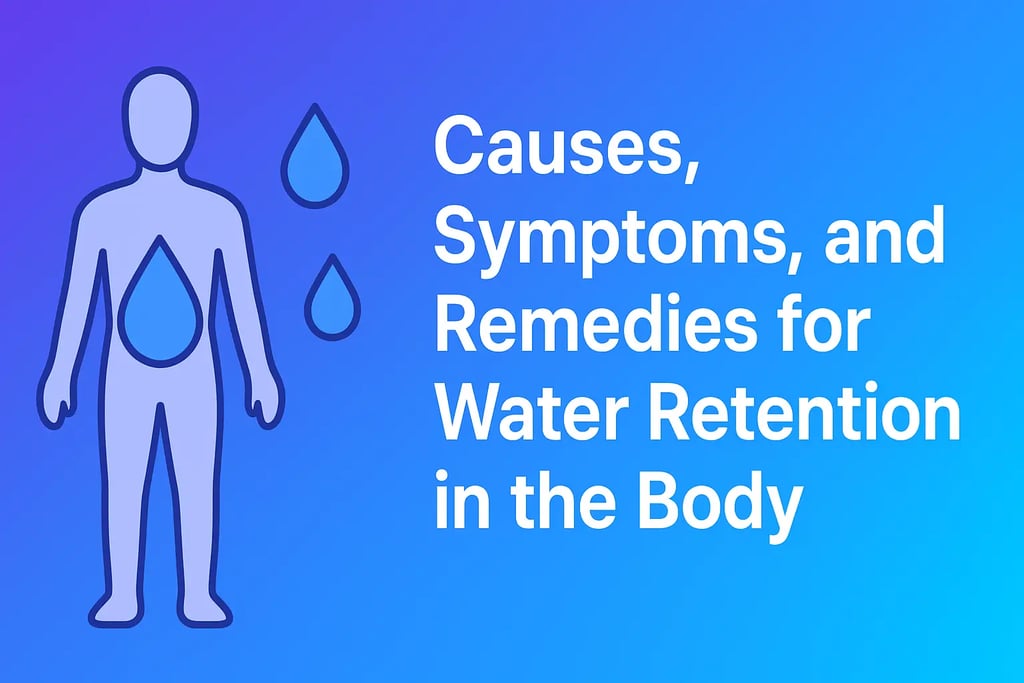Causes, Symptoms, and Natural Remedies for Water Retention (Edema)
Learn what causes water retention (edema), how to identify its symptoms, and discover effective natural remedies to reduce swelling and fluid buildup in the body.


Understanding Water Retention: Causes, Symptoms, and Effective Remedies
Water retention, medically known as edema, occurs when excess fluid accumulates within the body’s tissues. This condition can cause visible swelling, discomfort, and unexplained weight gain. The causes of water retention are diverse, ranging from diet and lifestyle factors to hormonal and medical conditions. Understanding what leads to water retention is essential for effective prevention and management.
Causes of Water Retention in the Human Body
Water retention can result from several interconnected factors, including dietary habits, circulation issues, hormonal changes, and underlying health conditions.
1. High Sodium Intake
One of the most common causes of water retention is consuming too much sodium. A high-salt diet prompts the body to retain water to maintain the proper electrolyte balance. This excess fluid can cause bloating and swelling, particularly in the hands, feet, and face. Reducing salt consumption is one of the most effective ways to manage mild edema.
2. Poor Blood Circulation
Inadequate circulation can lead to fluid buildup in the lower body, especially in people who sit or stand for long periods. When blood flow slows, fluids are more likely to pool in the legs, ankles, and feet. Those with heart disease or venous insufficiency are at higher risk of developing circulation-related edema.
3. Hormonal Fluctuations
Hormonal changes significantly influence fluid balance, especially in women. Variations in estrogen and progesterone levels during menstruation, pregnancy, or menopause can increase vascular permeability, allowing fluids to leak into surrounding tissues. These hormonal shifts are a common cause of temporary water retention.
4. Medical Conditions
Certain health conditions can lead to chronic water retention:
Kidney disease: Reduces the body’s ability to remove excess fluids.
Liver disease (cirrhosis): Alters protein levels, disrupting fluid regulation.
Heart failure: Weakens the heart’s pumping capacity, causing fluid buildup in the lungs and limbs.
5. Medications and Lifestyle Factors
Some medications, such as NSAIDs (non-steroidal anti-inflammatory drugs), corticosteroids, and blood pressure medications, can cause edema as a side effect. Additionally, lack of physical activity contributes to poor circulation, increasing the likelihood of fluid accumulation in the lower extremities.
Recognizing the Symptoms of Water Retention
Identifying the signs of water retention early can help prevent complications. Common symptoms of water retention include:
Swelling (Edema): Noticeable puffiness in the legs, ankles, feet, wrists, and abdomen.
Sudden Weight Gain: A rapid increase in weight, even without dietary or activity changes.
Tightness or Heaviness: A feeling of tightness or discomfort in swollen areas.
Stretched or Shiny Skin: The skin over affected areas may appear stretched or glossy.
Pitting Edema: When pressure applied to swollen skin leaves a temporary indentation.
If swelling persists or worsens, it may indicate an underlying medical condition that requires professional evaluation.
Effective Remedies for Reducing Water Retention
Managing water retention involves addressing its root causes through dietary changes, lifestyle modifications, and medical guidance.
1. Limit Salt Intake
Reduce your sodium consumption by avoiding processed and packaged foods. Opt for low-sodium alternatives and minimize the use of table salt. Reading nutrition labels carefully can help keep sodium levels in check.
2. Stay Hydrated
Contrary to popular belief, drinking more water can actually help reduce fluid retention. Proper hydration supports kidney function and helps flush excess sodium and waste from the body.
3. Engage in Regular Physical Activity
Exercise enhances blood circulation and helps move excess fluid out of tissues. Activities such as walking, swimming, cycling, or yoga can prevent fluid accumulation and promote overall cardiovascular health.
4. Elevate Affected Limbs
If swelling occurs in the legs or feet, elevating them above heart level several times a day can help fluid drain more efficiently.
5. Consume Potassium-Rich Foods
Potassium helps balance sodium levels and reduces fluid retention. Include foods like bananas, spinach, sweet potatoes, avocados, and oranges in your diet for natural relief.
6. Try Natural Diuretics
Herbal remedies such as dandelion extract and parsley tea can naturally stimulate urine production, aiding in fluid elimination. Always consult a healthcare provider before starting any supplements.
7. Address Underlying Health Issues
If water retention is linked to an underlying condition such as heart, kidney, or liver disease, medical treatment is essential. A healthcare professional may adjust medications or recommend specific therapies to manage symptoms safely.
Conclusion
Water retention (edema) is a common but often manageable condition. By understanding its causes, symptoms, and remedies, individuals can take proactive steps to maintain fluid balance and overall health. Simple lifestyle changes—like reducing salt intake, staying active, and staying hydrated—can make a significant difference. However, persistent or severe swelling should always be evaluated by a medical professional to rule out serious health concerns.
